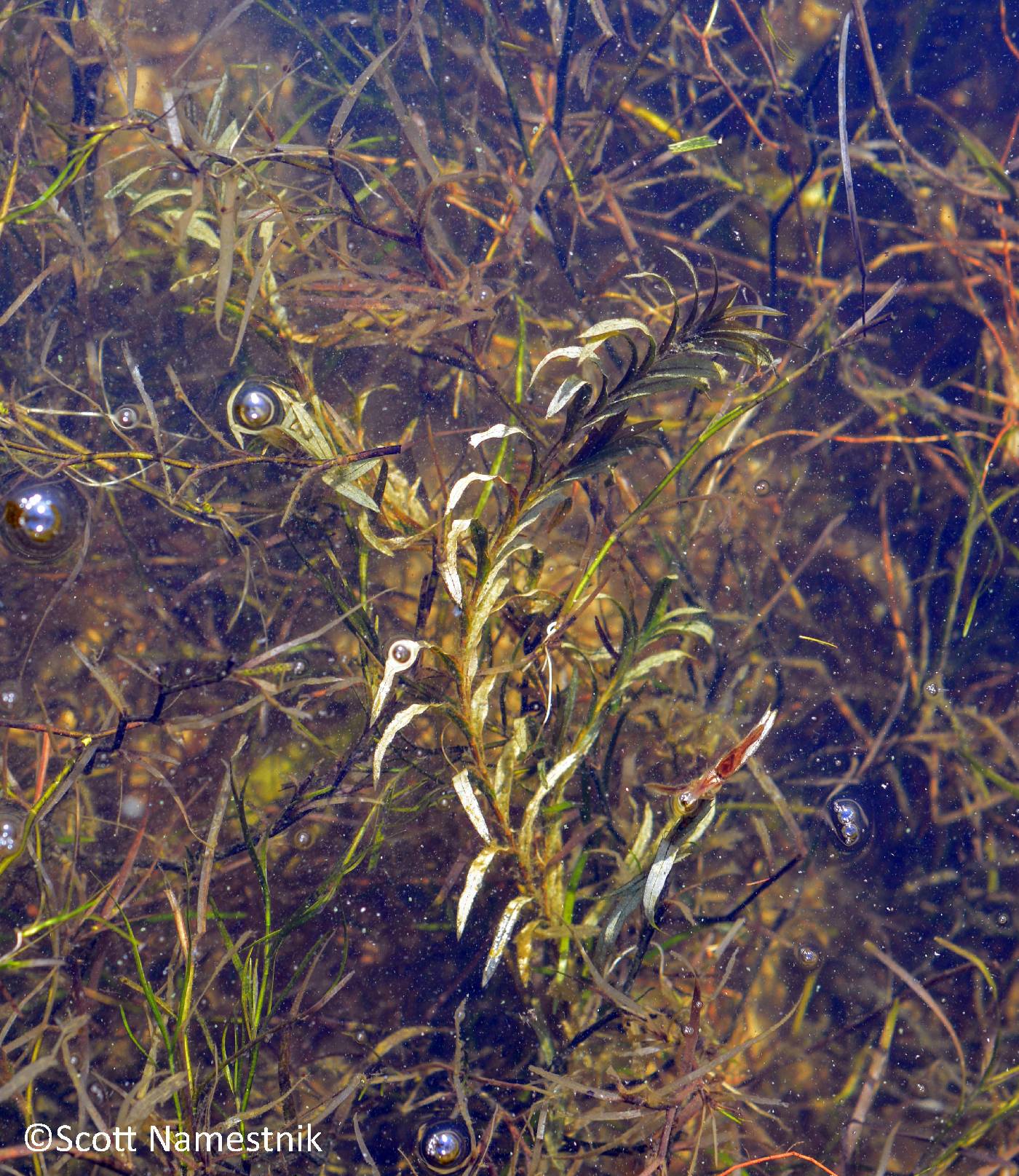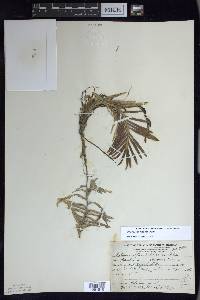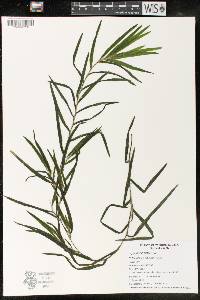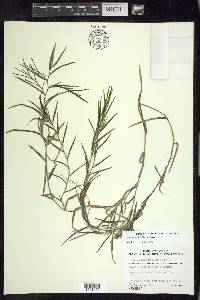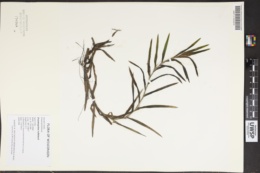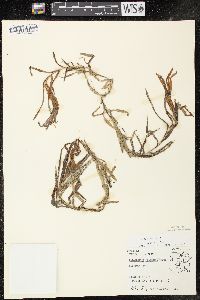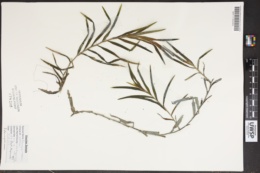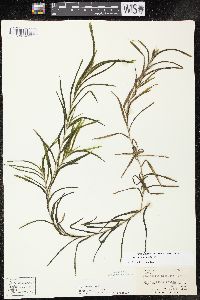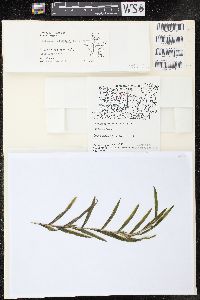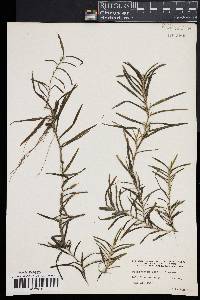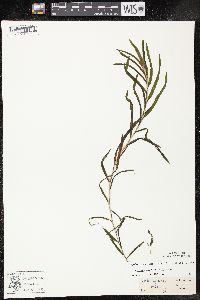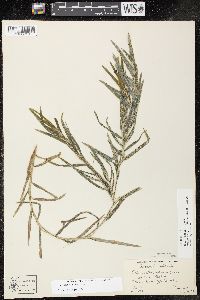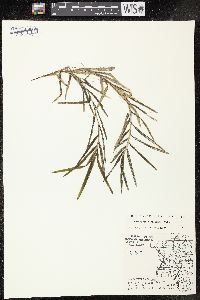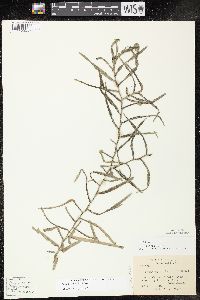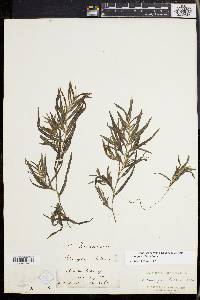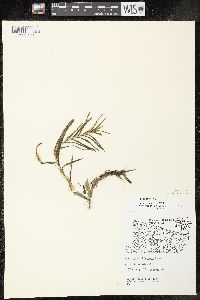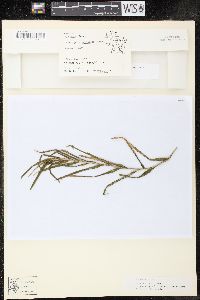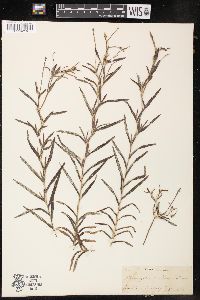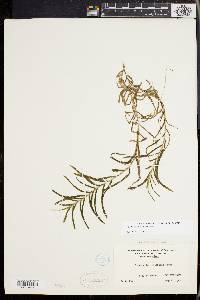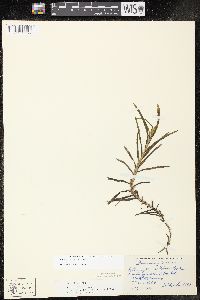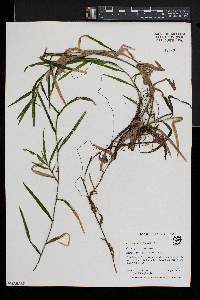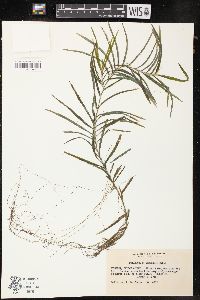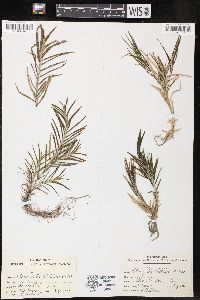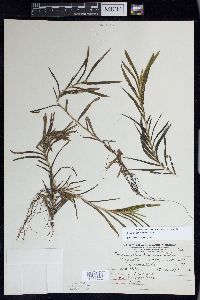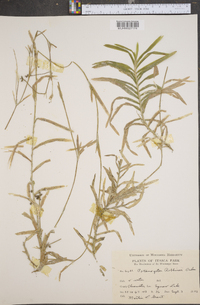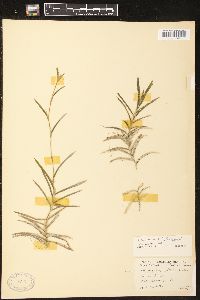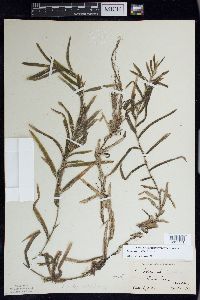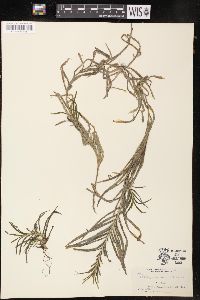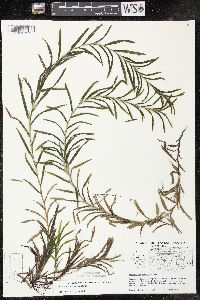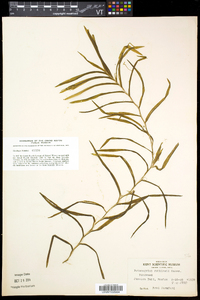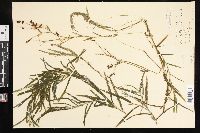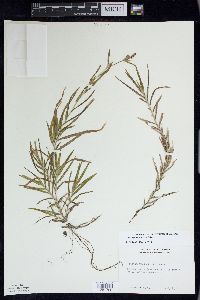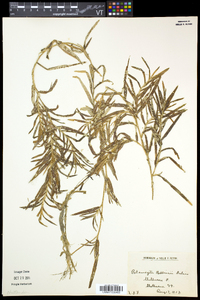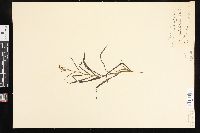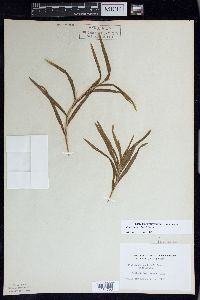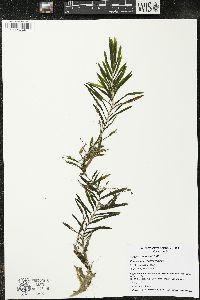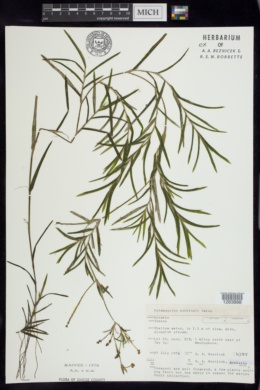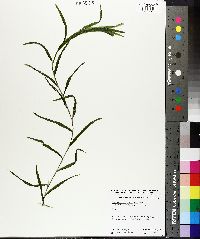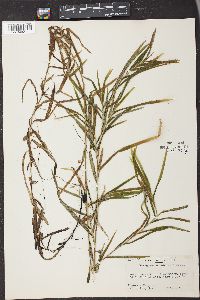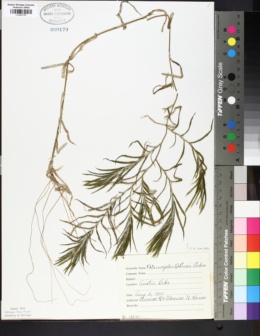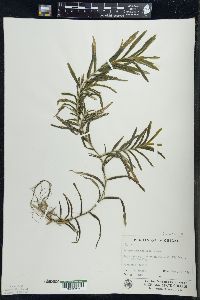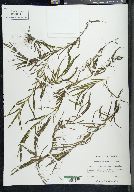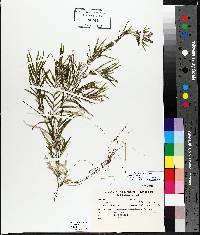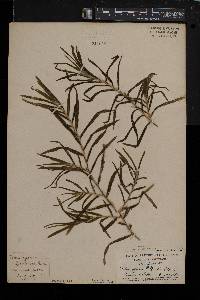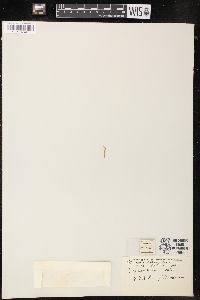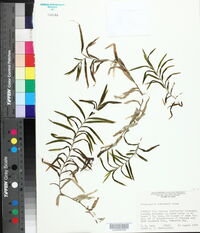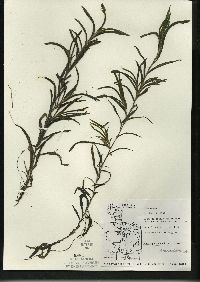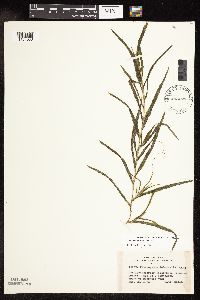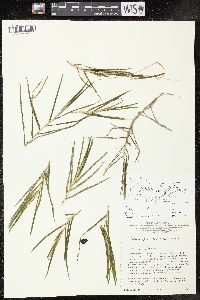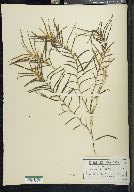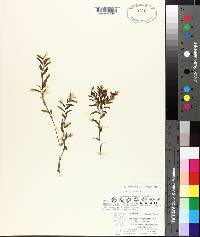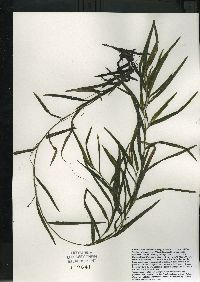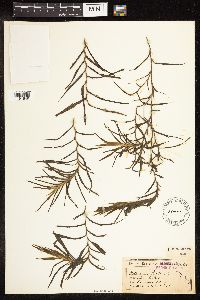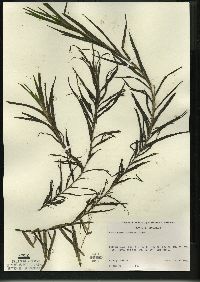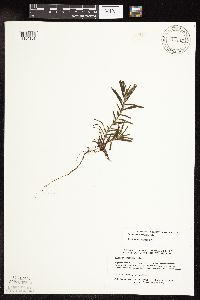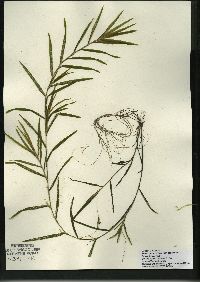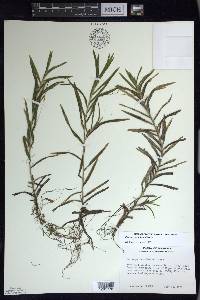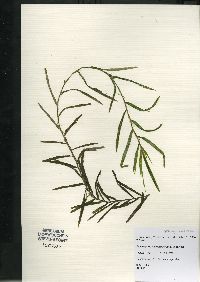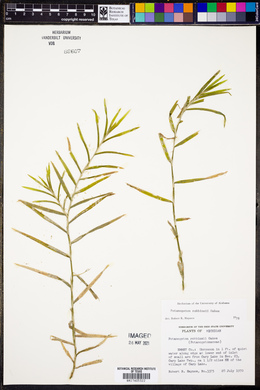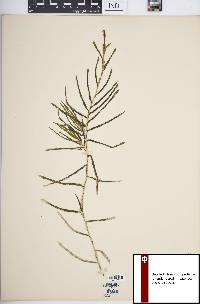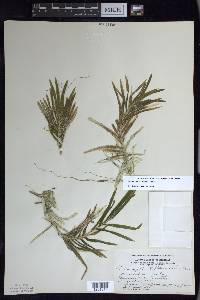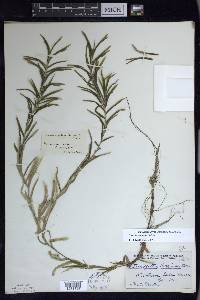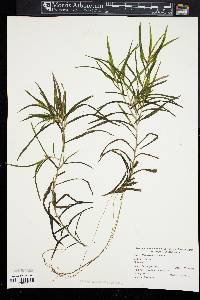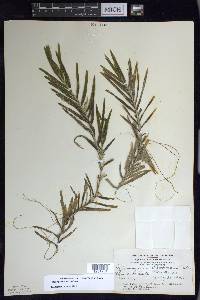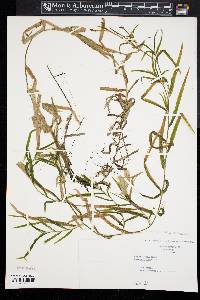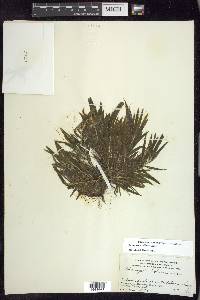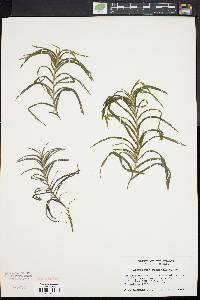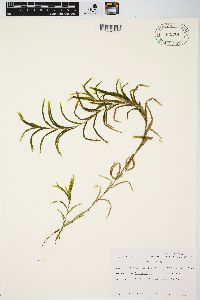Potamogeton robbinsii
|
|
|
|
Family: Potamogetonaceae
Fern Pondweed, more...Robbin's pondweed
[Potamogeton robbinsii f. cultellatus Fassett] |
Rhizomes present. Cauline stems terete, without spots, to 100 cm; glands absent. Turions absent. Leaves submersed, conspicuously 2-ranked, sessile, stiffish; stipules persistent, conspicuous, adnate to base of blade about ± ¼ length of stipule, connate, greenish brown to white, ligulate, 0.5--2 cm, fibrous, shredding at tip, apex obtuse; blade dark green to reddish green, linear to lanceolate, not arcuate, 2--7(--12) cm ´ 3--4(--8) mm, base rounded, with basal lobes, not clasping, margins minutely spinulose to serrulate, not crispate, apex not hoodlike, acute, lacunae absent; veins 20--60, fine. Inflorescences often branched; peduncles not dimorphic, axillary, erect, cylindric, 3--5(--7) cm; spikes not dimorphic, moniliform (i.e., beaded), 7--20 mm. Fruits stipitate, brown, obliquely obovoid, turgid, abaxially and laterally keeled, 3--4(--5) ´ 2(--3.3) mm, lateral keels without points; beak erect, recurved at apex, 0.7--0.9 mm; sides without basal tubercles; embryo with less than 1 full spiral. 2n = 52. Flowering late summer--early fall. Shallow to deep water of ponds, lakes, and slow-flowing rivers; 0--3000 m; Alta., B.C., Man., N.B., N.W.T., N.S., Nunavut, Ont., P.E.I., Que., Sask.; Ala., Alaska, Calif., Conn., Idaho, Ill., Ind., Maine, Mass., Mich., Minn., Mont., N.H., N.J., N.Y., Ohio, Oreg., Pa., R.I., Utah, Vt., Wash., Wis., Wyo. Potamogeton robbinsii is our most easily recognized species when it is fertile. It is the only species with branched inflorescences. The species, however, occurs in fairly deep water, forming large colonies that essentially cover the substrate. Only rarely do the plants flower. It also is the only species with truly auriculate leaves, the blades forming small lobes projecting past the stem on each side of the stem. Leaf blades of other Potamogeton species may have slightly rounded bases, but no others have lobes that actually protrude past the stem. The species has a fairly large disjunction; primarily known from the northern part of the flora, it also occurs in the Tensas River area, Baldwin County, Alabama. The Alabama population has been collected on at least two occasions over 40 years, once as recently as 1970.
Perennial submersed aquatic herb with rhizomes to 1 m tall Stem: sparsely branched below, much-branched above when flowering, jointed. Leaves: submersed, two-ranked, stalkless, translucent, dark green to reddish green, 2 - 10 cm long, 3 - 8 mm wide, linear to lance-shaped with a rounded base and pointed tip, basally lobed, minutely bristly or toothed, finely 20- to 60-veined, and firm. Stipules adhered to base of leaf blade about a fourth of their length, white to greenish brown, rolled up, 0.5 - 2 cm long, fibrous, shredding at tip. Inflorescence: an upright, slender, beaded-like (moniliform) spike of whorled flowers, branched, 7 mm - 2 cm long, on an axillary stalk. Stalks numerous, cylindrical, 2 - 5 cm long. Flowers: greenish, tiny. Stamens four. Anthers two-chambered, with four edge-to-edge sepal-like outgrowths. Fruit: an achene, stalked, brown, 3 - 4.5 mm long, 2 mm wide, obliquely reverse egg-shaped, plump, keeled, with an upright, 0.7 - 0.9 mm long beak. Dorsal keel narrow, sharp. Lateral keels two, rounded. Similar species: Easily distinguished by its basally lobed leaves and branched inflorescences. Flowering: June to September Habitat and ecology: Local in shallow lakes. Occurence in the Chicago region: native Notes: Plants in the genus Potamogeton are very important to wildlife, offering habitat and food for many aquatic animals. Etymology: Potamogeton comes from the Greek words potamos, meaning river, and geiton, meaning neighbor, referring to the habitat of these plants. Robbinsii is named after James Watson Robbins (1801-1879), the pioneer student of the genus. Author: The Morton Arboretum Stems to 1 m, sparingly branched below, repeatedly branched above when flowering; rhizome not tuberous; lvs all submersed, crowded on sterile stems (the internodes often only 1 cm), rather firm, distichous, linear, 3-10 cm נ3-8 mm, abruptly contracted and with rounded auricles at the juncture with the stipule, with prominent midvein and numerous (20-60) fine lateral veins, the margin pale and somewhat cartilaginous, usually minutely spinulose-serrulate at least toward the acute tip; stipular sheath open, adnate to the blade for 5-15 mm, the free part as long or longer, soon disintegrating into coarse fibers; peduncles numerous, almost paniculate, 2-5 cm, subtended by stipular sheaths with the blades much reduced or none and often accompanied by winter-buds; spikes slender, 7-15 mm, with 3-5 separated whorls of fls; achenes rarely produced, obovoid, 3.5-4.5 mm, with a narrow, sharp dorsal keel and 2 rounded lateral ones; 2n=52. Quiet water; Que. to B.C., s. to Del., Ala., Minn., and Oreg. Gleason, Henry A. & Cronquist, Arthur J. 1991. Manual of vascular plants of northeastern United States and adjacent Canada. lxxv + 910 pp. ©The New York Botanical Garden. All rights reserved. Used by permission. From Flora of Indiana (1940) by Charles C. Deam In a few lakes of the lake area. …… Indiana Coefficient of Conservatism: C = 10 Wetland Indicator Status: OBL |

